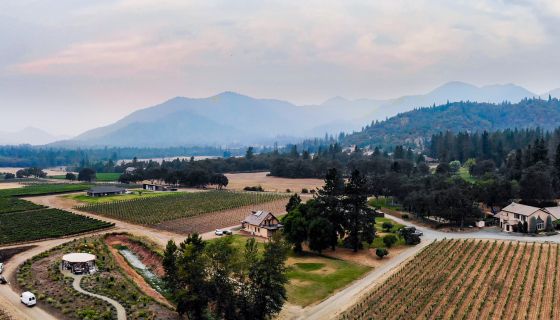Jeff Burrows writes WSET Diploma and certified WSET educator, freelance writer, photographer and videographer. I am the author of a food, wine and wine travel blog at www.foodwineclick.com'.
Regeneration of Vineyard and Team at Troon
"When you embark on a team project such as Regenerative Organic Certification or Biodynamics the goal itself changes the culture of the entire company and brings the team closer together. The shared mission of doing something that matters, not just to a business, but to the planet changes, in fact, regenerates, the team along with the soils and plants." Craig Camp, Troon Vineyard General Manager
Troon Vineyard Background
Troon Vineyard is located in the Applegate Valley in Southwestern Oregon. Originally planted in 1972, the vineyard had always been managed conventionally but by 2015, it was no longer in good health with many vines degraded by disease. In 2017, new owners Denise and Bryan White engaged Craig Camp as general manager with a plan to replant the entire farm in stages. In 2017, Craig and his team shifted the farm practices to Organic and added Biodynamic practices in 2018. By 2020, the team completed USDA Organic certification for both vineyard and winery followed immediately by Demeter USA Biodynamic certification.
Old diseased vineyard blocks were being replanted, biodynamic preparations were being made from materials on-farm with the help of a neighboring organic dairy. Biodynamic compost piles had been in use for several years to improve soil health all around the property. Sheep and chickens were being introduced and allowed to graze in the vineyard during the dormant season. Driving around the property, one can see the wildflower garden, used for the herbs needed for biodynamic preparations, a re-wilded beehive in which honey is not removed, and trees all around the farm. The team decided to continue the process by pursuing the new Regenerative Organic Certification (ROC).
Three Pillars of Regenerative Organic Certification
Regenerative Agriculture focuses on soil health and land management, with a goal of increasing soil organic matter and carbon sequestration. The new Regenerative Organic Certification goes further, extending the measures to include animal welfare and farmer/worker fairness. The certification applies to farms of all types and all geographies. The ROC standard starts with a requirement of organic certification to enter the program. There are three levels in the certification to allow farms to promote their participation at the basic bronze level while working to achieve the higher silver and gold levels over time. Third party audits are required to achieve and maintain certification, however existing standards are utilized where possible to avoid duplication of efforts. Regenerative practices include continuous cover crops, crop rotation, reduced or no-till soil management. Soil health is tested regularly with an eye to improvement over time. Animal welfare starts with USDA organic requirements and includes requirements based on the Five Freedoms of Animal Welfare. Farmer and worker fairness requirements include following all labor laws, fair and living wages, allowance for unions and prohibition of child labor and forced labor. While these requirements seem basic in the U.S., ROC is intended for use worldwide where these standards may not be in place or enforced.
Regenerative Viticulture at Troon Vineyard
Craig said the move to ROC was straightforward. Biodynamic practices did not need modification as they coincided with ROC. Removing and replanting the old diseased vine blocks allowed conversion to no-till practices. Animal welfare was integrated from the time the animals arrived on-farm. As the animals are used for their weeding and fertilizing abilities and not as a market product, the requirements were simple to implement.
Troon Vineyard was the second winery in the world to complete the new ROC certification with Silver Certification in 2021. As Craig explains "USDA Organic tells you what not to do, Biodynamics builds a proactive probiotic program that rebuilds natural soil systems, ROC pushes you to improve the health of your soils and plants every year."
Craig explained "The biggest barrier was the social pillar, as the certifying agencies did not really know how to deal with a small farm that already followed Federal and State OSHA regulations and operated in a competitive job market that had pushed wages above average already." When extra vineyard labor is required at pruning and harvest, Troon uses a local vineyard management partner who employs permanent workers who are well trained in field work, also following federal and state regulations.
Wine's Role in Promoting Regenerative Practices
The team at Troon plans to complete ROC Gold certification this year. When asked what's next, Craig talks about hosting ROC events to teach others working in the wine industry. Craig stated: "The advantage that wine has in spreading the word is that it's not such a perishable product. I can put it in a bottle, put the logo of ROC on the label and ship it almost anywhere in the world. If you're growing wheat or radishes, it's pretty hard to do that. I think wine has a unique role in this mission for building biodynamics and ROC, the fact that we can gain this type of attention. This is an important duty and role for wineries".
As for the quality of the wines, Eric Asimov, the New York Times wine critic has this to say: "While I admire the way Troon farms and its empirical attitude, the proof is in the wines, which are invariably fresh, lively and expressive."
For a short video showing the regeneration at Troon vineyard, follow this link.
Image of workers filling cow horns kindly provided by Craig Camp. All other images are the author's own.

















